おすすめの Google 拡張機能です!新しい言葉を勉強しましょう!
Here are the recommended Chrome extensions! Let’s learn new words here!
ポッドキャストプラットフォーム|Platforms of Podcast
こちらの記事は、配信中のポッドキャストのスクリプトです。
ぜひ、ポッドキャストを聞きながら読んでください。
 えみ先生
えみ先生もう聞いた人は、クイズをチェックしましょう!
ちょっとクイズ!|CHOTTO Quiz!
ポッドキャストを聞いた人は、ちょっとクイズを解いてみましょう。
むずかしいときは、下のスクリプトを読んで、もう一度クイズをチェックしてみてください。
【えいご】English Translation
Answer these quiz questions if you’ve listened to a new episode of my podcast.
If it was difficult, read the transcript below and try again.
❓ えみ先生が 先週行ったイベントは なんですか?|What is the event Emi-sensei went last week?
先週、大阪万博に行きました。4月から10月まで イベントがあります。
She went to the Osaka Expo. The event is from April to October.
❓ えみ先生は、どんなアプリをおすすめしましたか?|What apps did Emi-sensei recommend?
発音のアプリをおすすめしました。JAccentとAomi Japaneseというアプリです。
She recommended the apps for pronunciation. Those apps are called JAccent and Aomi Japanese.
❓ なんの店で ひらがなワークブックを 買うことができますか?|What store can you buy Hiragana workbooks?
ダイソーという100円ショップで 買うことができます。📚
You can buy them at Daiso, 100-yen shop.
ポッドキャストのスクリプト|Transcript of Podcast
エピソード27、「日本語、どうやって 勉強してる?」
このポッドキャストは、初中級(Pre-Intermediate)レベルです。
おはようございます。こんにちは。こんばんは。
日本語の先生、エミです。
先週、大阪に行ってきました。
今、大阪で大きいイベントがあるんですけど、みなさん、何かわかりますか?
クイズです。3つヒントがあります。
ヒント1:このイベントは長いです。
4月から始まって10月まで続きます。
ヒント2:いろんな国の文化を見ることができます。
ヒント3:「ミャクミャク」という名前の、ふしぎなマスコットキャラクターがいます。
どうですか?わかりましたか?
【えいご】English Translation
Good morning. Hello. Good afternoon.
I am a Japanese teacher, Emi.
Last week, I went to Osaka.
There’s a big event happening in Osaka right now.
Can you guess what it is? It’s a quiz!
Here are three hints:
Hint 1: This event is long. It started in April and continues until October.
Hint 2: You can see the cultures of many different countries.
Hint 3: There’s a strange mascot character called “Myakumyaku.”
How is it? Do you know the answer?
正解は、「大阪万博」です。
万博は、Expoです。
先週は、大阪で万博に行ってきました。
4月にも1回行ったので、先週は、2回目の万博でした。
7月は、日本は、とても暑くなっているので、たくさん汗をかきました。
たくさん水を飲んで、何回も日焼け止めをぬりました。
だから、あんまり日焼けしませんでした。
よかったです。
みなさんも、もし日本に来たら、万博 行ってみてください。
10月までです。
【えいご】English Translation
The correct answer is the Osaka Expo.
In Japanese, “banpaku” means Expo.
Last week, I went to the Expo in Osaka.
I also went once in April, so last week was my second time.
In July, Japan is really hot, so I was sweating a lot.
I drank a lot of water and put on sunscreen many times.
Because of that, I didn’t get sunburned very much. I’m glad about it.
If you come to Japan, please try going to the Expo too.
It lasts until October.
ここで先週の質問をチェックしましょう。
先週は こんな質問をしました。
「勉強のために どんなものを使っていますか?」
こんな質問でした。
【えいご】English Translation
Alright, now let’s check last week’s question.
Last week, I asked this question:
“What tools or materials do you use for studying?”
That was the question.
今日は、私が使っているもの、そしておすすめの勉強ツールを いくつか紹介したいと思います。
みなさんは日本語を勉強するとき、どうやって勉強していますか?
アプリ?YouTube?教科書?ノート?
いろいろなやり方がありますよね。
【えいご】English Translation
Today, I’d like to talk about the tools I use, and also introduce some recommended study tools.
When you study Japanese, how do you study?
Apps? YouTube? Textbooks? Notebooks?
There are many ways, right?
先週、デジタル派、アナログ派という言葉もすこし話しました。
「〇〇派」というフレーズ、前にちがうエピソードで話したことがあります。
AとB、どっちが好きか、自分のタイプを話すときに使います。
デジタル派は、スマホやパソコン、タブレットなどのテクノロジーを使うことです。
アナログ派は、教科書を使ったり、ノートにたくさんメモをしたりするタイプですね。
みなさんはデジタル派ですか?アナログ派ですか?
【えいご】English Translation
Last week, I also mentioned the terms digital-ha and analog-ha.
I talked about this kind of “〇〇-ha” phrase in a different episode before.
We use it to talk about our preference when comparing A or B.
Digital-ha means using technology like smartphones, computers, and tablets.
Analog-ha is the type that uses textbooks or takes a lot of handwritten notes in notebooks.
Which one are you—digital-type or analog-type?
私はデジタル派です。
私が今、勉強の時によく使っているのはiPadです。
ノートに書くより、iPadに書いたほうが いつでもチェックできるし、たくさんのワークシートや教科書のデータを入れられるので とても便利です。
【えいご】English Translation
I’m a digital person.
What I use a lot for studying right now is an iPad.
Writing on the iPad instead of on paper is more convenient because I can check it anytime, and I can store a lot of worksheets and textbooks.
私は5年前、日本語の先生になるために 学校で勉強をしました。
そのときは、毎日 教科書やワークシートをたくさん使っていました。
でも、全部の教科書を持っていくのは大変でした。
だから、教科書をPDFにしてiPadに入れました。
PDFにしたらiPadだけ持てばいいので、とても楽でした。
今でもiPadをよく使っています。
【えいご】English Translation
Five years ago, I studied at a school to become a Japanese teacher.
At that time, I used a lot of textbooks and worksheets every day.
But carrying all those books was tough.
So I turned the textbooks into PDFs and put them on my iPad.
If I have them as PDFs, I only need to carry the iPad. It was really easy.
I still use my iPad a lot.
あと、YouTubeもよく見ます。
英語を勉強するときは、YouTubeで勉強することが多いです。
たとえば、アメリカのスーパーで買い物をする動画とか、旅行のVlogを見ます。
楽しく見ながら、言葉や表現(Expression)を覚えられます。
みなさんは、どんなYouTubeを見ていますか?
どんな日本語の動画が見たいですか?
私はYouTubeにVlogを投稿しています。
これから、文法や言葉の動画も作りたいです。
リクエストがあったらぜひ教えてください。
【えいご】English Translation
Also, I often watch YouTube.
When I study English, I often use YouTube.
For example, I watch videos of people shopping in American supermarkets or travel vlogs.
They’re fun to watch, and I can learn new words and expressions at the same time.
What kind of YouTube videos do you watch?
What kind of Japanese videos do you want to see?
I upload vlogs to YouTube.
From now on, I want to make videos about grammar and vocabulary too.
If you have any requests, please let me know.
あと、最近はアプリで日本語を勉強する人も多いですね。
今日は、私のおすすめのアプリを2つ紹介します。
この2つは発音のアプリです。
【えいご】English Translation
Also, many people these days use apps to study Japanese.
Today, I’ll introduce two apps I recommend.
These two are pronunciation apps.
1つ目のおすすめのアプリは、JAccentです。
J-A-c-c-e-n-t、ジャクセントです。
このアプリは発音をチェックできます。
たとえば、雨(あ\め)と飴(あ/め)。
同じ「あめ」ですが、発音が すこし違いますよね。
雨(あ\め)はRain、飴(あ/め)はCandyです。
私は日本人ですけど、ときどき忘れてしまいます。
でも、JAccentで正しい発音をチェックして、聞いて、覚えることができます。
おすすめです。
【えいご】English Translation
The first app is JAccent.
It’s spelled J-A-c-c-e-n-t.
This app lets you check pronunciation.
For example: áme (あめ) and aḿe (あめ).
They’re the same word, but the pronunciation is slightly different.
“áme” (雨) means rain, and “aḿe” (飴) means candy.
Even though I’m Japanese, I sometimes forget.
But with JAccent, I can check the correct pronunciation, listen, and remember.
I recommend it.
2つ目のおすすめは、Aomi Japaneseです。
このアプリはスピーキングの練習ができます。
たくさん文や言葉があるので、その文を読んで、自分の発音が正しいかどうかチェックしてくれます。
最初のユニットは無料です。
発音が気になる人には、ぴったりのアプリです。
ぜひ使ってみてください。
【えいご】English Translation
The second app is Aomi Japanese.
This app lets you practice speaking.
It has a lot of sentences and words, and you can read them and check if your pronunciation is correct.
The first unit is free.
If you care about pronunciation, it’s the perfect app.
Please try using it.
iPad、YouTube、アプリ…。
これはデジタル派の勉強のし方ですね。
もちろん、アナログ派の人にもおすすめのツールがあります。
【えいご】English Translation
iPad, YouTube, apps…
these are digital study methods.
Of course, I also have recommendations for analog learners.
みなさん、もし日本に住んでいたら、ダイソーというお店に行ってみてください。
日本に住んでいなくても、旅行に来たらダイソーに行ってください。
ダイソーは100円ショップです。
日本だけじゃなくて、外国にもたくさんお店がありますね。
みなさんの国にもダイソーありますか?
【えいご】English Translation
If you live in Japan, please try going to a shop called DAISO.
Even if you don’t live in Japan, go there if you visit.
DAISO is a 100-yen shop.
Not only in Japan—there are many stores overseas too.
Is there a DAISO in your country?
ダイソーには、子ども用のひらがなワークブックがたくさんあります。
しかも、100円です。安いです。
かんたんで、わかりやすくて、とってもいいですよ。
とっても おすすめです。
ひらがなとかカタカナとか、あと動物や食べ物のフラッシュカードも売っています。
デザインがかわいくて、勉強するのが楽しくなります。
日本にはワークブックがたくさんありますけど、外国のダイソーにはないかもしれません。
チェックしてみてください。
【えいご】English Translation
At DAISO, they sell Hiragana workbooks for kids.
And they’re only 100 yen. It’s cheap!
They’re simple, easy to understand, and really good.
I really recommend them.
They also sell flashcards of hiragana, katakana, animals, and foods.
The designs are cute, and it makes studying more fun.
There are many workbooks in Japan, but overseas DAISO stores might not have them.
Please check and see.
もうひとつ、おすすめの勉強方法があります。
日本語で日記を書くことです。
これはデジタル派の人でもできるし、アナログ派の人でもできますね。
【えいご】English Translation
One more study method I recommend is…
writing a diary in Japanese.
This is something both digital and analog learners can do.
私がアメリカに留学した時は、英語の勉強のために できるだけ毎日、1行日記を書いていました。
One line diaryですね。
私は、英語で日記を書きましたけど、みなさんは日本語で日記を書いてみてください。
【えいご】English Translation
When I studied abroad in America, I tried to write a one-line diary in English every day to practice.
It’s a “one-line diary.”
I wrote in English, but I recommend you try writing in Japanese.
たとえば、
「今日はカフェに行きました。たのしかったです。」
このくらい みじかい文でも大丈夫です。
たくさん書かなくてもいいです。
毎日すこしずつ書くことが だいじです。
【えいご】English Translation
For example:
“I went to a café today. It was fun.”
Even just a short sentence like this is fine.
You don’t need to write a lot.
Writing a little bit every day is important.
みなさんは、日本語で日記を書いたことがありますか?
よかったら、今日のことを一文だけ書いてみてください。
そして、コメントで教えてくれたらとっても嬉しいです。
お願いします。
【えいご】English Translation
Have you ever written a diary in Japanese?
If you want, try writing just one sentence today.
And if you leave a comment to share it, I’ll be really happy.
Please do!
では、今日も みなさんに 質問があります。
「好きな日本語のフレーズや、おもしろいと思った言葉はありますか?」
来週は、日本語の若者言葉、スラングをチェックしてみましょう。
日本語のスラング、みなさんは使えますか?
コメントで、ぜひスラングを使ってみてください。
【えいご】English Translation
Now, I have a question for you today, as always.
“Do you have a favorite Japanese phrase or a word you found interesting?”
Next week, we’ll check out Japanese slang and youth words.
Can you use Japanese slang?
Please try writing slang in the comments!
今日のポッドキャストのスクリプトは、私のウェブサイトにあります。
ウェブサイトは、 en-nihongo.com です。
よかったら、ポッドキャストの感想や、質問の答えをコメントで教えてください!
じゃあ、また来週のポッドキャストで会いましょう。
じゃあね~!
【えいご】English Translation
A transcript for today’s podcast is on my website.
The website is en-nihongo.com .
I’d be very happy if you could share your thoughts/impressions or could answer the question I asked in this episode!
I’ll see you in the next episode.
Jaa ne-!
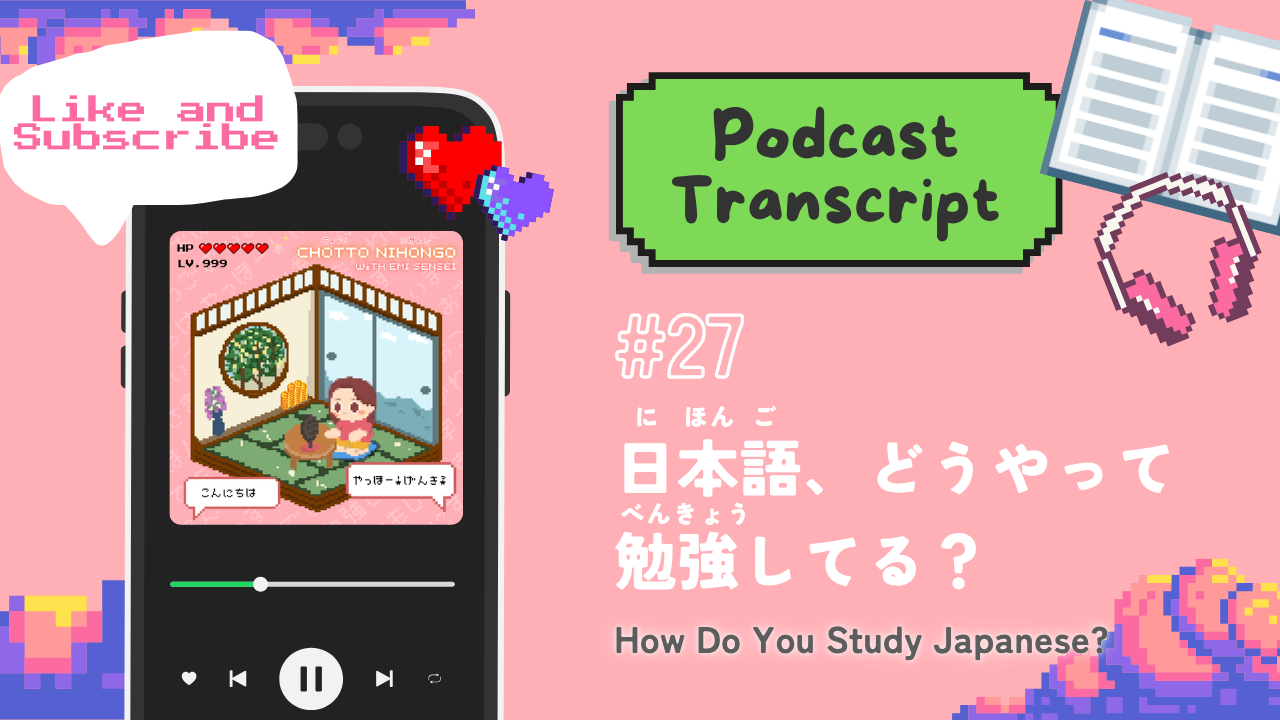
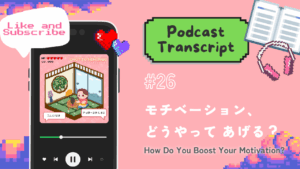
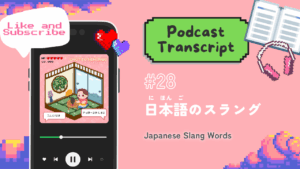
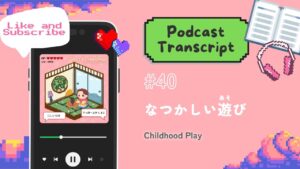
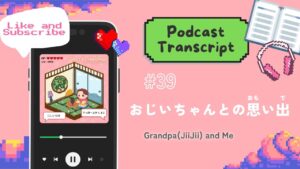
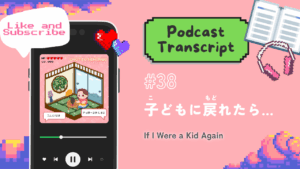
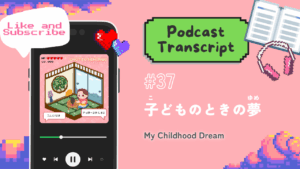
コメント|Comment